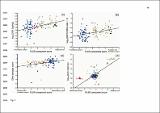Por favor, use este identificador para citar o enlazar a este item:
http://hdl.handle.net/10261/108218COMPARTIR / EXPORTAR:
 SHARE SHARE
 CORE
BASE CORE
BASE
|
|
| Visualizar otros formatos: MARC | Dublin Core | RDF | ORE | MODS | METS | DIDL | DATACITE | |

| Título: | Chronic exposure to low-dose radiation at Chernobyl favours adaptation to oxidative stress in birds |
Autor: | Galván, Ismael CSIC ORCID ; Bonisoli-Alquati, Andrea; Jenkinson, Shanna; Ghanem, Ghanem; Wakamatsu, Kazumasa; Mousseau, Timothy A.; Moller, Anders P. | Palabras clave: | Adaptation Chernobyl Ionizing radiations Oxidative stress Pheomelanin |
Fecha de publicación: | 2014 | Editor: | British Ecological Society | Citación: | Functional Ecology, 28(6): 13-87-1403 (2014) | Resumen: | 1.Ionizing radiation produces oxidative stress, but organisms can adapt to their exposure with physiological adaptive responses. However, the role of radioadaptive responses in wild populations remains poorly known. 2.At Chernobyl, studies of birds and other taxa including humans show that chronic exposure to radiation depletes antioxidants and increases oxidative damage. Here, we present analyses of levels of the most important intracellular antioxidant (i.e. glutathione, GSH), its redox status, DNA damage and body condition in 16 species of birds exposed to radiation at Chernobyl. We use an approach that allows considering the individual bird as the sampling unit while controlling for phylogenetic effects, thus increasing the statistical power by avoiding the use of species means as done for most previous comparative studies. 3.As a consequence, we found a pattern radically different from previous studies in wild populations, showing that GSH levels and body condition increased, and oxidative stress and DNA damage decreased, with increasing background radiation. Thus, when several species are considered, the overall pattern indicates that birds are not negatively affected by chronic exposure to radiation and may even obtain beneficial hormetic effects following an adaptive response. Analysis of the phylogenetic signal supports the existence of adaptation in the studied traits, particularly in GSH levels and DNA damage. 4.We also show that, under equal levels of radiation, the birds that produce larger amounts of the pigment pheomelanin and lower amounts of eumelanin pay a cost in terms of decreased GSH levels, increased oxidative stress and DNA damage, and poorer body condition. Radiation, however, diminished another potential cost of pheomelanin, namely its tendency to produce free radicals when exposed to radiation, because it induced a change towards the production of less pro-oxidant forms of pheomelanin with higher benzothiazole-to-benzothiazine ratios, which may have facilitated the acclimation of birds to radiation exposure. 5.Our findings represent the first evidence of adaptation to ionizing radiation in wild animals, and confirm that pheomelanin synthesis represents an evolutionary constraint under stressful environmental conditions because it requires GSH consumption | Versión del editor: | http://dx.doi.org/10.1111/1365-2435.12283 | URI: | http://hdl.handle.net/10261/108218 | DOI: | 10.1111/1365-2435.12283 |
| Aparece en las colecciones: | (EBD) Artículos |
Ficheros en este ítem:
| Fichero | Descripción | Tamaño | Formato | |
|---|---|---|---|---|
| Chernobyl_birds.pdf | Texto artículo | 688,11 kB | Adobe PDF |  Visualizar/Abrir |
| Chernobyl_birds 2.pdf | Figuras | 412,46 kB | Adobe PDF |  Visualizar/Abrir |
CORE Recommender
SCOPUSTM
Citations
110
checked on 20-abr-2024
WEB OF SCIENCETM
Citations
105
checked on 27-feb-2024
Page view(s)
649
checked on 24-abr-2024
Download(s)
673
checked on 24-abr-2024
Google ScholarTM
Check
Altmetric
Altmetric
NOTA: Los ítems de Digital.CSIC están protegidos por copyright, con todos los derechos reservados, a menos que se indique lo contrario.
